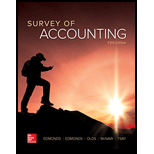
a)
Determine the expected net income when 500 people buy the ticket
a)
Explanation of Solution
Given information:
The sale price of ticket is $28. Fee is $10,000 fixed.
The formula to calculate the net income:
Compute the net income:
Hence, the net income is $4,000.
The price of the speaker will remain same irrespective of fixed fee or fee of $20 per ticket sold.
b)1.
Determine the net income and percentage change in net income if the sale of tickets is 10% higher than expected
b)1.
Explanation of Solution
Given information:
Refer above part for net income:
Compute the net income:

The net income is $5,400.
Compute the percentage growth in net income:
Hence, the percentage growth in net income is 35%.
2.
Determine the net income and percentage change in net income if the sale of tickets is 10% lower than expected and the fixed fee is $10,000.
2.
Explanation of Solution
Given information:
Refer part a) for net income:
Compute the net income:
Excel spread sheet:
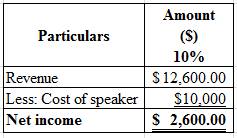
Excel workings:

The net income is $2,600.
Compute the percentage growth in net income:
Hence, the percentage growth in net income is 35%.
3.
Determine the net income and percentage change in net income if School P pays Person L $20 per ticket sold. The sale of tickets is 10% higher than expected.
3.
Explanation of Solution
Given information:
Refer part a) for net income:
Compute the net income:
Excel spread sheet:
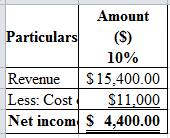
The net income is $4,400.
Excel workings:
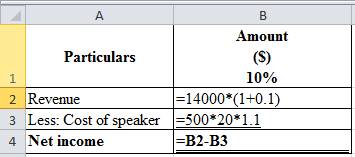
Compute the percentage growth in net income:
Hence, the percentage growth in net income is 10%.
4)
Determine the net income and percentage change in net income if School P pays Person L $20 per ticket sold and the sale of tickets is 10% lower than expected.
4)
Explanation of Solution
Given information:
Refer part a) for net income:
Compute the net income:
Excel spread sheet:
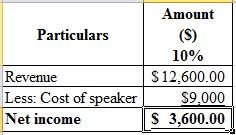
The net income is $3,600.
Excel workings:

Compute the percentage growth in net income:
Hence, the percentage growth in net income is 10%.
c)
Discuss the discrepancies if any arises on the computation presented at the board by the spokesperson and by the other groups.
c)
Explanation of Solution
There are no discrepancies in the computation presented at the board by the spokesperson and by the other groups.
d)1.
The kind of cost structure produces the greater growth potential in the profitability of the company.
d)1.
Explanation of Solution
The fixed cost structure produces the higher growth potential in company’s profitability.
This is because of operating leverage.
2.
The type of cost structure produces the higher risk of company’s declining profitability.
2.
Explanation of Solution
The fixed cost structure produces the higher risk of company’s declining profitability.
This is because of operating leverage.
3.
The circumstances under which the company pursue to establish a fixed cost structure
3.
Explanation of Solution
The circumstances where the sales of the company expected to raise are where the fixed cost structure is established.
4.
The circumstances under which the company pursues to establish a variable cost structure
4.
Explanation of Solution
The circumstances where the sales of the company expected to drop are where the variable cost structure is established.
Want to see more full solutions like this?
Chapter 11 Solutions
Survey Of Accounting
- 1. Define working capital and explain its importance in financial health and liquidity management. 2. Assess how the matching concept and accrual basis affect the reporting of current assets and liabilities. 3. Using a hypothetical balance sheet (you may create one), identify at least 5 current assets and 5 current liabilities and analyze how changes in these elements affect liquidity ratios. 4. Recommend at least two strategies VinGrenDom Ltd. can implement to optimize working capital.arrow_forwardNonearrow_forwardNo Ai Answerarrow_forward
- I need the correct answer to this financial accounting problem using the standard accounting approach.arrow_forwardTheron Interiors manufactures handcrafted cabinetry and uses a process costing system. During the month of October, the company started Production on 720 units and completed 590 units. The remaining 120 units were 60% complete in terms of materials and 40% complete in terms of labor and overhead. The total cost incurred during the month was $45,000 for materials and $31,200 for labor and overhead. Using the weighted-average method, what is the equivalent unit cost for materials and conversion costs (labor and overhead)?arrow_forwardGeneral Accountingarrow_forward
- Kamala Khan has to decide between the following two options: Take out a student loan of $70,000 and study accounting full time for the next three years. The interest on the loan is 4% per year payable annually. The principle is to be paid in full after ten years. Study part time and work part time to earn $15,000 per year for the following six years. Once Kamala graduates, she estimates that she will earn $30,000 for the first three years and $40,000 the next four years. Kamala's banker says the market interest for a ten-year horizon is 6%. Required Calculate NPV of the ten-year cash flows of the two options. For simplification assume that all cash flows happen at year-end. Based on the NPV which of the two options is better for Kamala?arrow_forwardFinancial Accountingarrow_forwardPlease give me answer with general accountingarrow_forward
 Managerial Accounting: The Cornerstone of Busines...AccountingISBN:9781337115773Author:Maryanne M. Mowen, Don R. Hansen, Dan L. HeitgerPublisher:Cengage LearningPrinciples of Accounting Volume 1AccountingISBN:9781947172685Author:OpenStaxPublisher:OpenStax College
Managerial Accounting: The Cornerstone of Busines...AccountingISBN:9781337115773Author:Maryanne M. Mowen, Don R. Hansen, Dan L. HeitgerPublisher:Cengage LearningPrinciples of Accounting Volume 1AccountingISBN:9781947172685Author:OpenStaxPublisher:OpenStax College College Accounting, Chapters 1-27AccountingISBN:9781337794756Author:HEINTZ, James A.Publisher:Cengage Learning,
College Accounting, Chapters 1-27AccountingISBN:9781337794756Author:HEINTZ, James A.Publisher:Cengage Learning,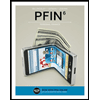 PFIN (with PFIN Online, 1 term (6 months) Printed...FinanceISBN:9781337117005Author:Randall Billingsley, Lawrence J. Gitman, Michael D. JoehnkPublisher:Cengage Learning
PFIN (with PFIN Online, 1 term (6 months) Printed...FinanceISBN:9781337117005Author:Randall Billingsley, Lawrence J. Gitman, Michael D. JoehnkPublisher:Cengage Learning





